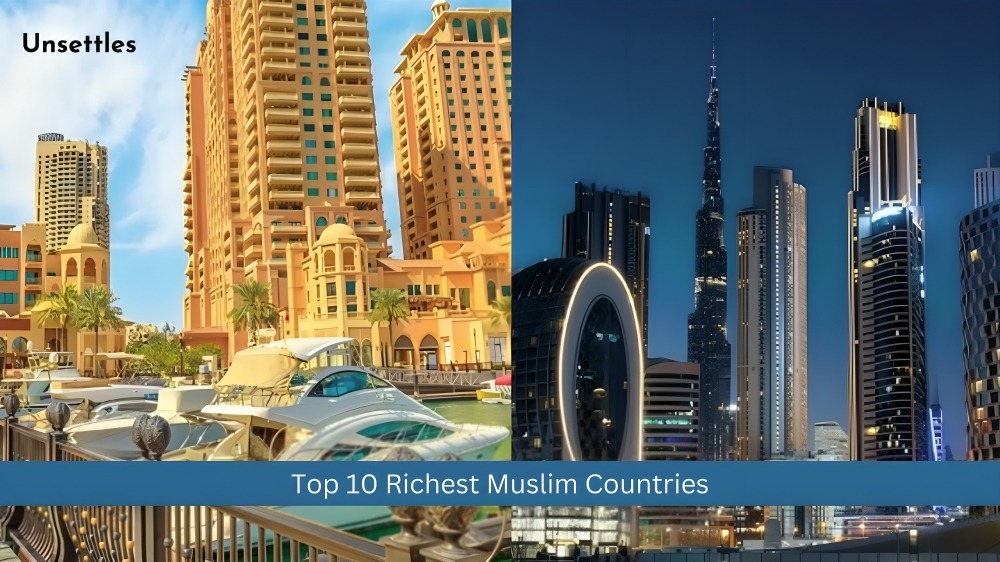When it comes to the world’s wealthiest nations, Muslim countries often dominate the conversation, largely due to their vast oil and natural gas reserves. Over the years, countries like Qatar and Saudi Arabia have built massive fortunes thanks to their abundant natural resources. However, there’s a new wave of transformation happening—many Muslim nations are now diversifying their economies, reducing their reliance on oil, and expanding into other sectors like finance, tourism, technology, and more.
In today’s post, we’ll explore the top 10 richest Muslim countries in the world in 2024, examining not only their wealth but also how they’re shifting towards more sustainable, diversified economic growth.
1. Qatar
GDP per Capita: $118,150
At the top of the list is Qatar, boasting an impressive GDP per capita of $118,150. This small Gulf nation may have a modest population, but its wealth is immense, primarily fueled by vast reserves of natural gas and oil. Since hosting the FIFA World Cup in 2022, Qatar has seen a surge in infrastructure development, as well as growth in finance, construction, and services. This has turned Qatar into one of the most prosperous and forward-thinking countries in the world.
2. United Arab Emirates (UAE)
GDP per Capita: $92,950
The UAE is a shining example of how a nation can transition from oil dependency to a diversified economy. With a GDP per capita of $92,950, the UAE thrives through its investment in real estate, tourism, aviation, and renewable energy. The iconic cities of Dubai and Abu Dhabi showcase futuristic skyscrapers and global business hubs, turning the UAE into a major trading bridge between East and West.
3. Saudi Arabia
GDP per Capita: $71,370
Known as the world’s largest oil producer, Saudi Arabia has a GDP per capita of $71,370. While oil remains its backbone, the country is now pursuing Vision 2030, a plan to diversify its economy. This includes developing sectors like health, education, tourism, and renewable energy. With these transformative efforts, Saudi Arabia is preparing itself for a future beyond oil, focusing on innovation and global investments.
4. Bahrain
GDP per Capita: $62,750
Bahrain might be one of the smallest countries in the Gulf, but it has a GDP per capita of $62,750. While oil and gas still play a role in its economy, Bahrain has diversified into banking, finance, and tourism. Its liberal trade policies and business-friendly environment make it a key player in the post-oil economy.
5. Kuwait
GDP per Capita: $53,760
Kuwait stands out with its massive oil reserves, contributing to its GDP per capita of $53,760. However, the country is looking ahead with its New Kuwait 2035 development plan, aiming for sustainable growth in various sectors such as finance, education, and tourism. Kuwait’s sovereign wealth fund, one of the oldest in the world, is a major tool in this transformation.
6. Turkey
GDP per Capita: $43,620
Turkey is a unique blend of cultures and economies, reflected in its GDP per capita of $43,620. Its strategic location between Europe and Asia, combined with a robust manufacturing, tourism, and agricultural sector, makes Turkey one of the most dynamic economies in the Muslim world. A large, young population further fuels its economic engine, while massive infrastructure projects continue to boost its growth.
7. Oman
GDP per Capita: $40,020
With a GDP per capita of $40,020, Oman is a prime example of a country seeking to balance its reliance on oil with other growth sectors. Its strategic location along key shipping routes has led to booming industries in logistics, shipping, and tourism. Major investments in port development and free zones are helping Oman become a diversified player in the global economy.
8. Malaysia
GDP per Capita: $39,070
Malaysia boasts a GDP per capita of $39,070 thanks to its diversified economy. While the country produces natural commodities like palm oil and rubber, it is also a leading exporter of tech products like semiconductors. Malaysia’s vision of becoming a fully developed nation is being realized through its focus on technology, biotechnology, and manufacturing, positioning it as a global economic hub.
9. Kazakhstan
GDP per Capita: $34,480
Kazakhstan is often overlooked but is a rising star with a GDP per capita of $34,480. Rich in oil, gas, and minerals, Kazakhstan is working on economic diversification through agriculture, finance, and technology. Its Kazakhstan 2050 Strategy aims to modernize the economy, ensuring that it remains a key player in the Central Asian region.
10. Libya
GDP per Capita: $26,530
Despite ongoing political challenges, Libya has a GDP per capita of $26,530, thanks to its vast oil reserves. Oil still dominates its economy, but rebuilding efforts focus on stabilizing and reconstructing the nation. Libya’s future growth hinges on resolving internal conflicts and boosting sectors beyond oil.
Frequently Asked Questions (FAQs)
Which is the richest Muslim country in 2024?
Qatar ranks as the richest Muslim country in 2024, with a GDP per capita of $118,150, thanks to its vast natural gas reserves and economic diversification.
How are Muslim countries diversifying their economies?
Countries like Saudi Arabia and the UAE are diversifying through investments in technology, renewable energy, tourism, finance, and infrastructure, reducing reliance on oil and gas.
What is Saudi Arabia’s Vision 2030?
Vision 2030 is Saudi Arabia’s plan to diversify its economy beyond oil, focusing on improving sectors like health, education, tourism, and technology for sustainable growth.
Which Muslim country has the most dynamic economy?
Turkey has one of the most dynamic economies due to its strategic location, industrial base, tourism, and large youthful population driving economic growth.
Why is Bahrain considered a key player in the post-oil economy?
Bahrain has developed a strong banking and financial sector, liberal trade policies, and a growing tourism industry, positioning itself as a leader in the post-oil Gulf economy.
